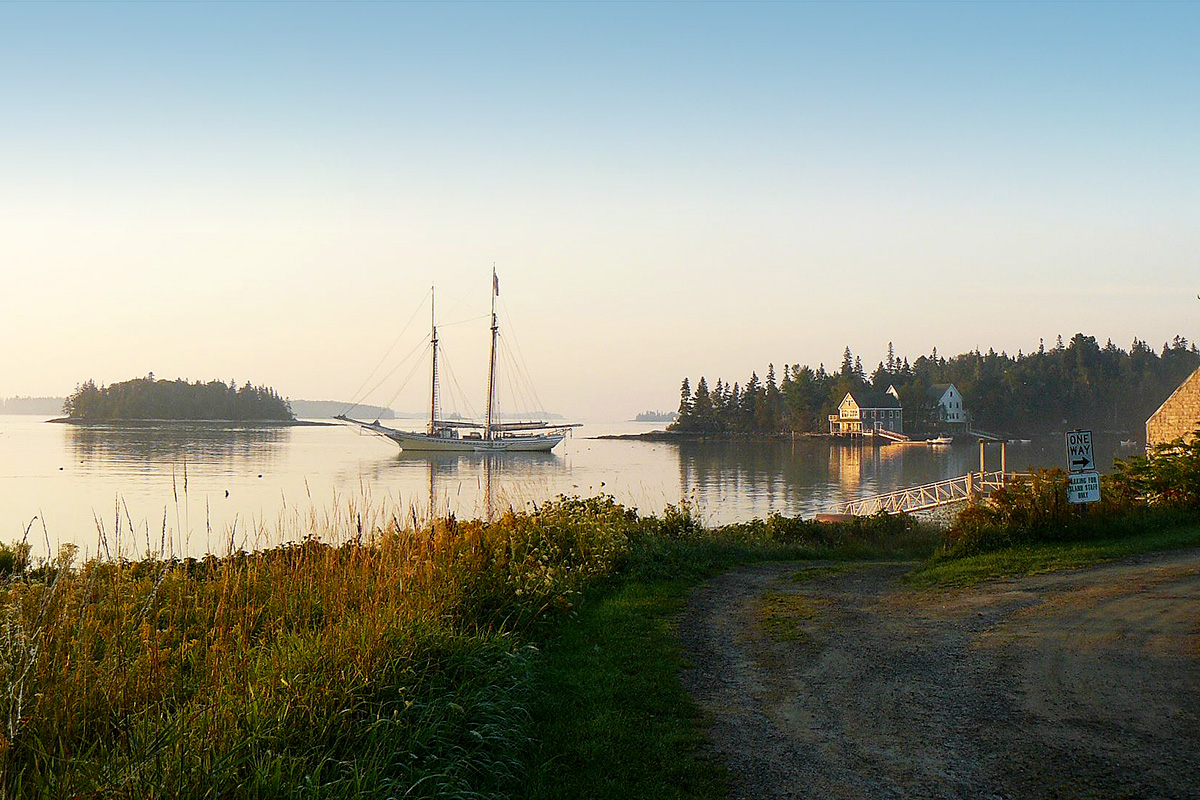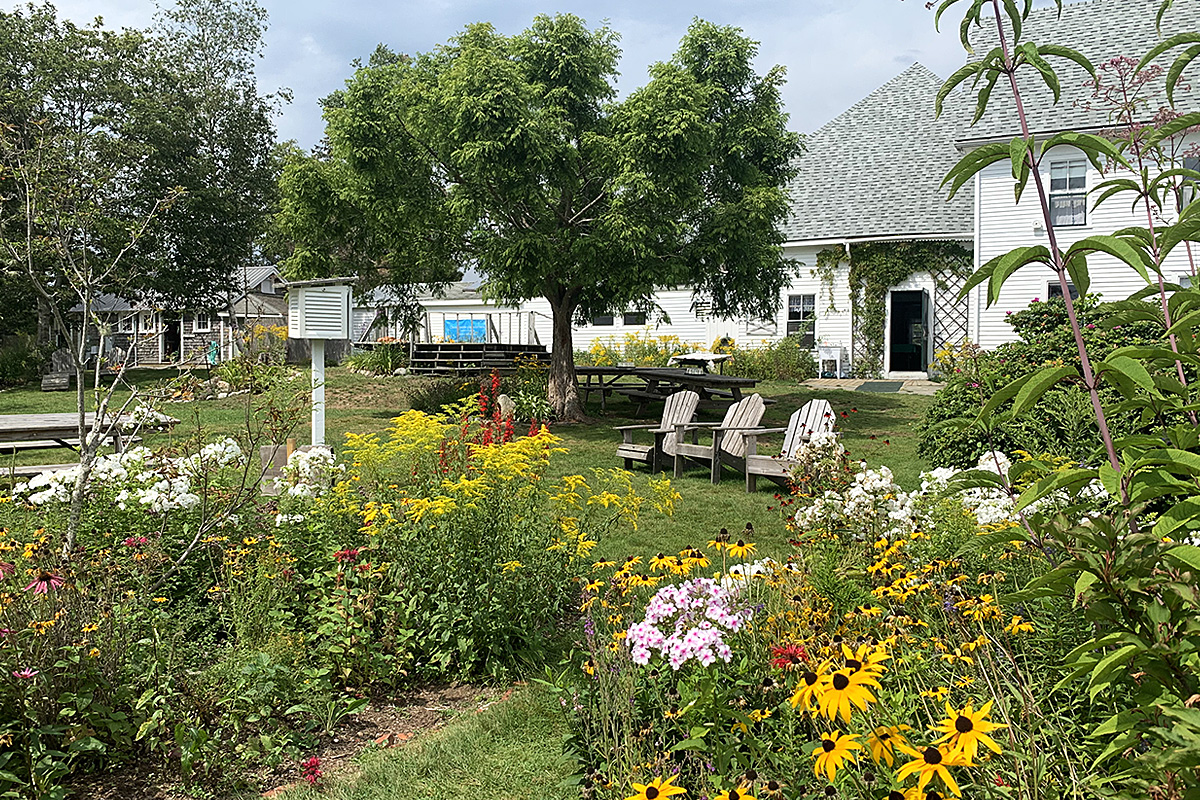Your Visit
What to Expect
Whether you’re preparing for a summer visit to Hog Island or you’re just starting to consider one, we want you to know what to expect when you arrive. Anticipation is running high as the miles from home grow and arrival at Hog Island begins to set in. Although this introduction was written many years ago, the timelessness of the experience has not changed, just a few minor tweaks here and there.

Reaching The Sanctuary
You hit Route 32 and are nearly “home free.” Keene Neck Road, the last leg, begins matter-of-factly enough with more forest then you round a bend and there’s a glimpse of openness and you spot the water just ahead and it passes to your right.
This is the head of Greenland Cove and if you look closely you’ll see evidence of changing tides — a sure bet you are looking at salt water! Keene Neck is a winding affair and calls for some patience and careful driving to follow it all the way to its end and arrival on the Todd Wildlife Sanctuary.
If you are arriving within the proscribed arrival time as per the information packet there will be a staff “greeter” to welcome you just as you come onto the sanctuary. You will instructed to drive on down to the boathouse where registration is taking place.
Just few car lengths down the driveway a striking and impressive view awaits you.
First Glimpses
Your home for the next week is there, just across the water.
There’s a cedar shingled building in the foreground that is perched right on the water with a ramp up to it. Just behind it is a gleaming white building — an inviting scene to be sure! You head downhill to the boathouse where you are greeted by staff doing registration and offload your luggage and park your car.

The walk from the parking lot down to the boat is the first chance to calm yourself enough to really breathe and take in the air and the sweeping view. A pond and meadow in the foreground give way to a mix of water and dots of land stretching toward the horizon.
You are now looking at a handful of some of the many thousands of islands that grace the coast of Maine. In a day or two you will be out on that water exploring the bay by boat and perhaps by foot on one of those islands out there.
From the Boathouse
At the boathouse you mill about with other arrivers awaiting your boat to Hog Island.
Meanwhile, a staff only boat transports your luggage and places it in your room – your home away from home for the week.
This is a good time to have your binoculars on the ready. There is much that can be seen while waiting. It is not uncommon to see osprey carrying fish to a nest, or black guillemots foraging, diving and rising to the surface, off to the left near all the lobster boats in the harbor.
From the dock, if it’s low tide, you can look into the water and perhaps glimpse a passing school of finger-length silversides (fish) or spot a sedentary sea-star in among the periwinkles scattered over the boulders.
Sometimes we see jellyfish or a harbor seal or even an American bald eagle.
All of this and you haven’t yet set foot on Hog Island!
The “All Aboard” command is shouted by the boat captain and you ease down the ramp and onto the boat, your ferry to Hog Island. The ride to the island is little more than a few minutes even though some prankish staff member is apt to try to humor some sort of imaginary long voyage.

Planting Your Feet
You reach the island dock and quickly learn that the shingled building perched on the water’s edge is called the Queen Mary — and it is one of the lodges, and you feel some impulse of hope that this is where you are assigned. After setting foot on the island by ascending the ramp and rounding the porch of the Queen Mary you come to the “Bridge.”
This is the hub of camp operations. Adirondack chairs are on the porch, a gift shop and dining hall are inside. Here a staff member greets all the arriving guests, gives a brief welcome and just enough of an orientation to get you acquainted with your surroundings and where to locate your lodge — where your quarters and luggage await. You look around and see some raised flower gardens, a small bird-pool with recirculating water, a building adorned with multi-colored lobster buoys with “Fish House” for a label, and a large bell.

The staff person announces that you will now be going by “bell time” and explains the signaling system and instructs you to take off your watch and get into the rhythm of the bell and the tides. “Your assignment,” suggests the staffer, “Is to relax, and allow us to nurture you while nature envelops you with her beauty and awe.” Just then you get a hint of fresh baked cookies or something wafting up from the dining hall and you are invited to get your gear settled in your lodge and then follow your nose back to see what goodies await you on the business end of that aroma.
A week on Hog Island is your passport to slow down, to really look into the wonders of nature all around you, to join in a special camaraderie inspired by good food, world-class instructors and the willingness to experience what many call “a life-changing experience.”
Be sure to thank the FOHI volunteers, many were former campers who keep coming back to help others have a “life-changing experience.”
Friends of Hog Island is a 501(c)(3) tax-exempt organization.
